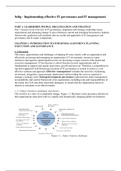Selig - Implementing effective IT governance and IT management
PART 1: LEADERSHIP, PEOPLE, ORGANIZATION AND STRATEGY
Part 1 focuses on an overview of IT governance, alignment and strategy, leadership teams,
organization and managing change. It also references current and emerging best practice industry
frameworks, guidelines and standards that are useful and applicable to IT management and
governance and its major components.
CHAPTER 1: INTRODUCTION TO IT/BUSINESS ALIGNMENT, PLANNING,
EXECUTION AND GOVERNANCE
1.2 Overview
The issues, opportunities and challenges of aligning IT more closely with an organization and
effectively governing and managing an organization’s IT investments, resources, major
initiatives and superior uninterrupted service are becoming a major concern of the board and
executive management. IT has become a critical function in most organizations and is
fundamental to support and sustain innovation, growth and survival. Therefore a comprehensive
top-down approach with bottom-up execution of IT governance is critical to achieve a cost
effective solution and approach. Effective ‘management’ includes the activities of planning,
investment, integration, measurement, deployment and providing the services required to
manage a strategic asset. Enterprise/corporate governance represents the entire management
accountability and control framework of an organization, including roles and responsibilities of
the board, the CEO and other functional managers, to ensure that the organization meets its
objectives and plans in an ethical manner.
1.2.1 Today’s business challenges and drivers
The world is in a time of a remarkable change. Figure 1.1 illustrates select pressures and drivers
that organizations must deal with in a rapidly and dynamically changing global environment.
Figure 1.1 - Today’s business challenges
,1.2.2 Scope and definition of enterprise governance and its relationship to business and IT
governance
Enterprise governance represents the highest level of organizational and managerial discipline.
Enterprise governance is the set of responsibilities and practices exercised by the board and
executive management with the goal of providing strategic direction, ensuring that plans and
objectives are achieved, assessing that risks are proactively managed and assuring that the
enterprise’s resources are used responsibility. In an increasingly IT-dependent world, with the
impact of the extraordinary changes like mobile and cloud technologies, social media and big
data, leaders of enterprises can no longer afford to ignore, delegate or avoid IT-related decisions.
Enterprise governance deals with the separation of ownership and control of an organization,
while business governance focuses on the direction, control and execution of the business plan
and strategies by the CEO and his team and IT governance focuses on the direction, control and
execution of IT plans and strategies. Figure 1.2 compares and differentiates the key
characteristics of enterprise governance vs. business governance vs. IT governance.
Enterprise Governance Business Governance IT Governance
Separation of ownership & Direction & control of the Direction & control of IT
control (board) business (CEO and (CIO and direct reports)
executives)
● Roles of board and ● Business strategy, plans & ● IT strategy, plans &
executives objectives objectives
● Regulatory compliance ● Manage execution ● Alignment with business
oversight ● Performance metrics, plans & objectives
● Shareholder rights controls and incentives ● IT assets and resources
● Business operations & ● Intellectual capital and ● Demand management
control oversight management/succession ● Value delivery and
● Financial accounting & planning execution management
reporting oversight ● Manage innovation, ● Risk, change &
● Risk management proactive change and performance management
oversight continuous improvements
Figure 1.2 - Comparing governances
1.2.3. The board’s role in IT governance
The board is forming a committee that focuses on IT strategy, investments and IT governance as
part of enterprise governance.
1.2.4. Major challenges and issues faced by IT
In figure 1.3, the IT challenges must be dealt with as part of an IT planning and governance
process are presented.
, Challenged Elements which should be in control, where you should focus
on when you talk about the changes related to IT
Total cost of ownership & ROI-based decisions for new investments based on IT-enabled
IT value proposition business changes, reducing costs, competitive differentiation and
keeping the lights on; do more with less; re-invest savings
SOX/other compliance Sustainable compliance model
Architecture & Implement scalable, secure, open architecture & standardized
applications solutions
Security & privacy Impenetrable, scalable and cost-effective security and privacy
policies, processes & controls
Asset optimization Optimal infrastructure and other asset utilization: physical assets,
human capital, strategic sourcing, cloud computing etc.
On demand management Manage on demand requests in a consistent manner and aligned
& IT investment with the business
Business/competitive Data strategy, business intelligence, data analytics and big data
intelligence
Talent development and People development, training and certifications, talent acquisition,
management succession planning
Figure 1.3 - IT challenges
1.3 Definition, purpose and scope of IT governance
Governance formalizes and clarifies oversight, accountability and decision rights for a wide
array of IT strategy, integration, resource and control activities.
The main purpose of IT governance is to align IT investments and priorities more closely with
the business strategy and risk appetite.
Key IT governance strategy and resource decisions must address the following topics: IT
principles, IT architecture, SOA architecture (service oriented architecture), IT enterprise
infrastructure, business application needs, IT investment and prioritization, people development,
and IT governance policies/processes/mechanisms/tools/metrics.
1.3.3. Successful IT governance is built on three critical pillars - (1) leadership, organization
and decision rights, (2) scalable processes and (3) enabling technologies
1. Leadership, organization and decision rights - defines the organization structure, roles
and responsibilities, decision rights, a shared vision and integration touch points and
champions for proactive change.
2. Flexible and scalable processes - the IT governance model places heavy emphasis on the
importance of process transformation and improvement (planning, project management etc)






